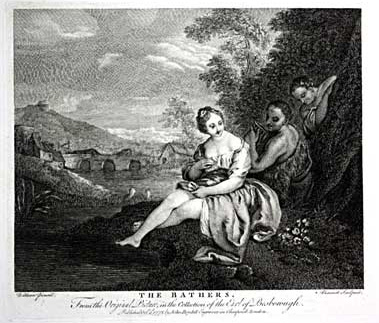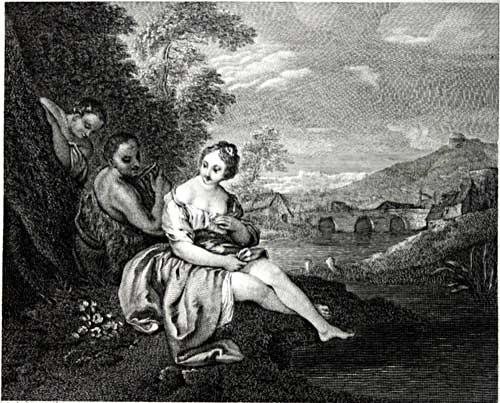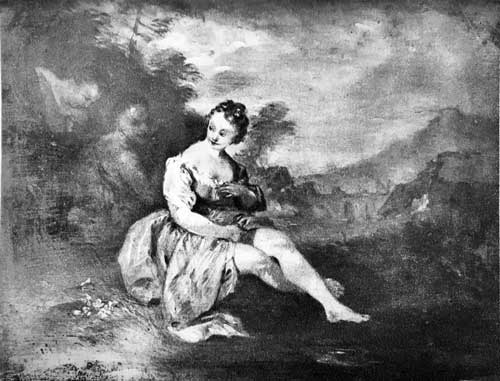
- Home Page
- Accepted
Paintings & Copies - Doubtful
Attributions - Doubtful Textual References
- Alternative
Titles - Collectors &
Museums - Bibliography
- Search Abecedario
- Watteau &
His Circle
X. Bathers
Entered September 2017

Whereabouts unknown
Material unknown
Measurements unknown
ALTERNATIVE TITLES
Baigneuse assise
Baigneuse et faune
Le Bain
Figures, in a Landscape
RELATED PRINTS

François Germain Aliamet “after Watteau,” Bathers, 1755, engraving.
The painting and its pendant, Bathing, were engraved in reverse by François Germain Aliamet (1734-1787) in October 1775 for the London publisher John Boydell. At the lower left appears “Watteau pinxit.”
PROVENANCE
London(?), collection of William Ponsonby, 2nd Earl of Bessborough (1704–1793. The Earl’s ownership is stated on Aliamet’s engraving. The picture passed by descent in his family.
West Hill, Wandswoth, collection of John George Brabazon Ponsonby, 5th Earl of Bessborough (1809–1880); his sale, London, Christie’s, July 10, 1850, lot 169: “Watteau . . . . Figures, in a landscape; and a lady bathing—a pair.” Sold for £23.12.6 according to an annotated copy of the sale catalogue in the Rijksbureau voor Kunsthistorische Documentatie.
Collection of E. Bolton in 1927. This provenance comes from Sir Robert Witt, as noted by Ingersoll-Smouse.
SELECT BIBLIOGRAPHY
Ottley, Notices of Engravers (1831), “Aliamet.”
Dacier, Vuaflart, and Hérold, Jean de Jullienne et les graveurs (1921-29), 1: p. 266, cat. 317 bis.
Ingersoll-Smouse, Pater (1928), under cat. 304.
Adhémar, Watteau (1950), cat. 241.
Macchia and Montagni, L’opera completa di Watteau (1968), cat. 6o-C.
REMARKS
This picture and its pendant are not by Watteau as was claimed in the eighteenth and nineteenth centuries but are by his pupil, Jean-Baptiste Pater or his shop. In fact, there are a number of versions of this composition by Pater and his shop. One is a painting in the Palais de Justice in Saint-Quentin, measuring 17 x 23 cm, which may afford a sense of the scale of the Bessborough picture. Adhémar erred in thinking that the painting in Saint-Quentin was the same as the one engraved by Aliamet. This cannot be. The Saint-Quentin painting can be traced to Paris in 1786 and 1822 while the work Aliamet knew remained with the Bessboroughs until 1850.
In all likelihood, this painting and its pendant appeared under Watteau’s name in one or more of the eighteenth-century London sales but their vague listings as scenes of women bathing do not allow any more precise identification.

